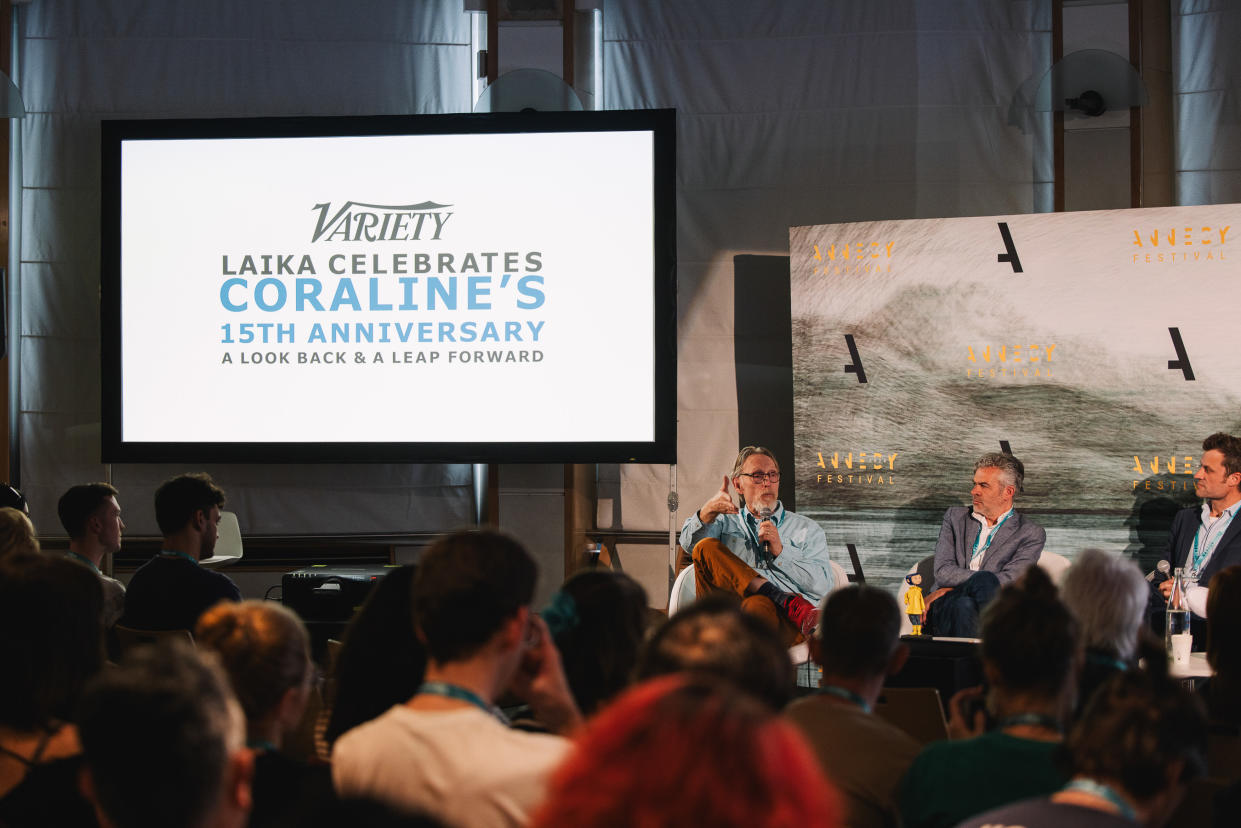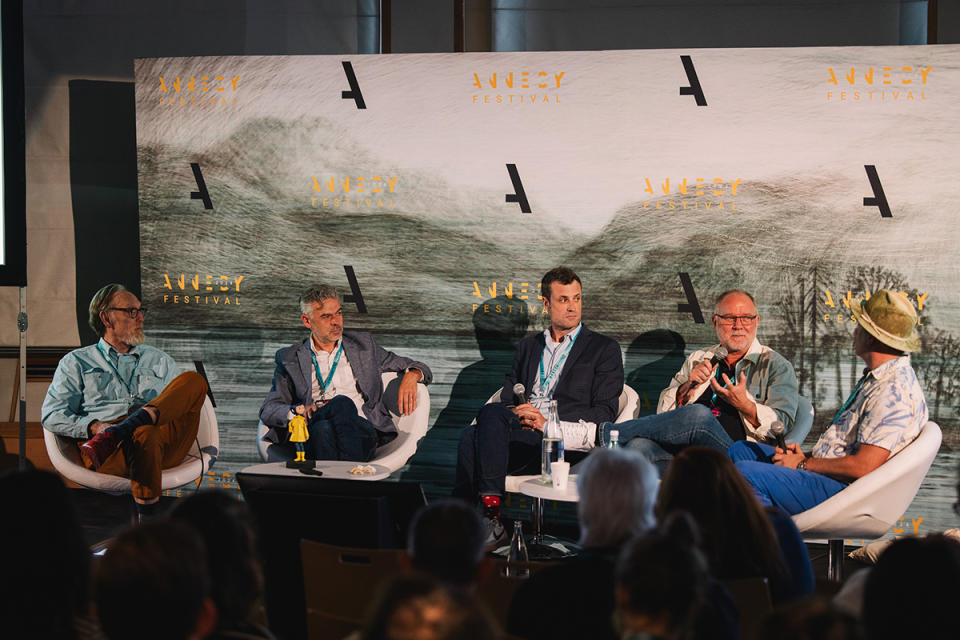Henry Selick Makes Surprise Appearance at Variety’s Annecy Panel on Laika, Talks ‘Ancient Magic’ of Stop-Motion and Remastered ‘Coraline’: ‘It’s Gorgeous’

Animation wizard Henry Selick has seen the remastered “Coraline.” And he loves it.
“It’s gorgeous. I saw it about a week and a half ago and it very much represents the original dream of how to use the 3D really well,” Selick said during a surprise appearance at Variety‘s “Laika Celebrates Coraline’s 15th Anniversary” panel at Annecy Animation Festival. “It took the original concept to a greater height.”
More from Variety
Moderated by Variety chief film critic Peter Debruge, Selick was joined by Laika’s Brian McLean (director of Rapid Prototype), Ollie Jones (director of Practical Effects) and Jeff Stringer (chief technology officer).
“I’ve gotten used to seeing ‘Coraline’ in 2D over the years, but nothing looks better in 3D than stop-motion,” Selick said, looking back at his years at Laika. “I was never more spoiled. I got support there like nobody’s business. Nobody was saying: ‘No, we don’t need that, we don’t believe in that.’ It was a place that would take crazy risks. I asked Phil Knight why he was getting into animation and he said, ‘Well, I’ve got a son [Laika’s president and CEO Travis Knight] who’s a genius.’ I said, ‘What do you want out of it?’ He replied, ‘I want to win.’ That’s what I went into and that’s what I found.”
“Coraline,” set for worldwide theatrical rerelease later this summer, was originally released in 2009. It is now regarded as an animation modern classic.
“I think that’s primarily because of its pure originality,” Stringer said. “Everything about it is so unique. Having rewatched it again recently, I was also struck by how innovative it was. There were many firsts in this film for stop-motion generally. One of the big ones was the use of stereoscopic 3D, which is what this rerelease is all about. What you’re going to see is not just the film you remember, but the film that was intended.”
While Selick said the changes are “minor” and “won’t make a difference to the audience,” Stringer added that the remastering takes advantage of “15 years of technology and tools.”
“With stop-motion, there’s a ton of things to clean up and you always wish you had more time,” he said, as McLean assured the audience the iconic heroine “didn’t get a facelift.”
Laika has come a long way, said Stringer – also praising “Coraline’s” late DoP Pete Kozachik – but everything started with that film.
“Henry wanted to bring the viewers into this miniature, handmade world. The key to this illusion was to shoot it in proper scale [for puppets],” he said. “Otherwise, the viewers would feel like giants. It’s one of those things that separates Laika’s films. When you’re watching them, the environment is alive in ways that aren’t typical in stop-motion.”
As noticed by McLean, Laika was the first studio to “take this crazy idea of using 3D printing for replacement animation.”

“Henry had directed a couple of stop-motion films before, one of which was ‘Nightmare Before Christmas,’ and [its character] Jack Skellington was very emotive. He had over 800 hand-sculpted faces,” he said. “The idea was to take this technique and see if we could harness the power of new fancy computer technology, animate faces in the computer, and then send them to these emerging 3D printers.”
They had no idea how challenging it would be.
“I remember telling the producer that all we needed was three people, one 3D printer and $30,000,” McLean added. “I wasn’t trying to be deceitful! That’s really what I thought because I figured we needed maybe 900 faces to beat Jack Skellington. I recognize how lucky we were because for months and months, we literally sat in a closed office with doors shut, where we failed test after test.”
If it wasn’t for Selick’s “trust and leadership,” the process would have stayed in that office. But McLean said that embracing new technology helped push the emotional range of a stop-motion character to a whole new level.
“For ‘Coraline,’ we printed 20,000 faces. For ‘Missing Link,’ we hold a world record for the most 3D printed faces in a stop-motion animated film. Now many others are competing in that category,” he said. “On [upcoming] ‘Wildwood,’ we are surpassing even that.”
According to Jones, Laika is all about making people feel “the artist’s hand in everything you see.”
“It’s a big part of our ethos,” he said. “When making ‘Coraline,’ we were also acknowledging the ordinary as extraordinary, which mirrored what she was experiencing during the movie.”
Stop-motion really brings people in, he said. “The process exists in the artist’s mind as well as the viewer’s. That’s pretty unique. When Coraline walks into the magic garden, we are not just experiencing the awe of the imagery. We are trying to unlock how the trick is done, but we also wanted to believe.”
Laika’s current quota amounts to 3.5 seconds of material per week.
“It’s important to point out that we are not driven by efficiency,” laughed Stringer, with McLean chiming in: “We have developed a hybrid approach to filmmaking, but it’s always grounded in these handmade crafts. My job doesn’t even make sense. We are animating faces in the computer months ahead of the body being animated. We do it backwards! People say, ‘Well, it must be quicker.’ ‘No.’ ‘It must be saving money.’ ‘No.’ ‘You must need less people.’ ‘No!’ The only reason is because it helps the story and it helps to push the characters in a new direction. And that’s all because of Henry and his vision. Thank you.”
Selick also took a moment to reflect on his career, saying that “the reason 3D even happened was because I knew its inventor, Lenny Lipton.”
“I visited him when ‘Coraline’ was maybe going to happen and I just felt this was what was missing,” he said. “I wanted there to be ‘The Wizard of Oz’ moment: Coraline would go from a flattened, gray world into this beautiful world of color and depth, and dimension, which ultimately turns dangerous.”
He is not against using CGI, however.
“I’m just a believer that wherever you can, make it handmade, but don’t hit people over the head with clumsiness,” he said. “Make it as magical and invisible as you can. Invite the audience in. They have to believe in the movie for it to be real, which means they have to get past some of the flaws and so forth. Don’t just bathe them in a perfect film that’s disposable.”
The best stop-motion films have a longer life than any other films, he observed.
“It’s some ancient magic. It’s the first magic of filmmaking: it’s so old it doesn’t get old,” he said. “As long as you avoid too many topical bits of humor, too many gizmos of the moment that don’t date well, the best stop-motion will continue to have this timeless quality.”
Best of Variety
Sign up for Variety’s Newsletter. For the latest news, follow us on Facebook, Twitter, and Instagram.


